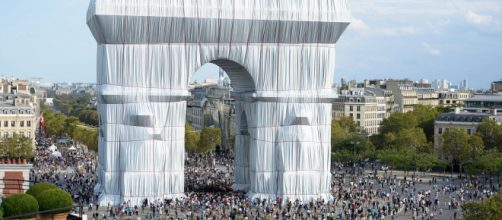A new public artwork that debuted this week spurs this question: what’s the point of making art that doesn’t last, and costs a mint to make?
The artwork was conceived by the late Christo and his wife Jeanne-Claude, famed for fabric-wrapping landmarks and landscapes. This time it’s the shrouding of L’Arc de Triomphe, which was completed posthumously on Sept. 20.
It took 1,200 workers to cover the structure with 270,000 square feet of polypropylene fabric, and on Oct. 3, they’ll undo it all.
What's it for?
As for the cost, according to Christo’s nephew Vladimir Yavachev, the amount will come in somewhere between $13.5 million and $16 million.
With an expense like that, the what-does-it-all-mean question goes pleading.
Like most good questions, there’s no one answer.
If you focus on the impermanence of the wrapping, two of them imply an answer. Cloaking the Arch of Triumph is one of these. It was Napoleon’s monument to all his military victories. And because his wins were short-lived, because he didn’t become the emperor of the world that he wanted to be, blanketing his monument with fluttering fabric becomes a morality lesson in how fleeting military conquest can be.
The same meaning could be assigned to the 1995 fabric-wrapped Reichstag, the Third Reich’s parliament house in Berlin. Covering it over, like wrapping a dead fish, spoke loudly about the Nazi’s lost cause.
Different raison d'etre
My interpretations of these wrapped landmarks aren’t everyone’s. For example, when it comes to the Arch of Triumph, Christo’s nephew told the NY Times, that his uncle “wanted a living object that, with its moving folds, would turn the monument’s surface into something sensual.”
But what explains Christo and Jeanne-Claude’s wrapping of landscapes?
Why did they feel it necessary to mask, say, the Floating Piers of Italy with 75,000 square feet of yellow fabric? Did they think the water view wasn’t scenic enough without their add-on of glistening fabric the color of the sun?
You could ask the same question about their 1983 wrap called “Surrounded Islands.” Eleven islands in Miami’s Biscayne Bay were hemmed in by 6,499,800 square feet of pink-colored polypropylene.
Why? What was the point of floating thousands of pink fabrics? I’ll get back to this question in a moment.
I can’t do this story without also mentioning the couple’s California project Running Fence in 1976, a 24.5 mile, 18-foot-high wall of white nylon that stretched across the hills of Sonoma and Marin counties.
As you can imagine, not everyone wanted what Christo and Jeanne-Claude were offering. To get Surrounded Islands okayed, the photographer Wolfgang Volz reported in his book “Nomads for Art,” the couple endured long and expensive legal fights with local wildlife groups.
But nothing beat the 26-year wait time for the couple to get approval for The Gates in Manhattan’s Central Park in 2005: 7,503 reddish-colored pathway drapes extended for 23 miles.
So, back to my question about the point of wrapping landscapes. What was the couple trying to do, improve on Mother Nature? Why go to the trouble of redrafting natural beauty? But wait, couldn’t we ask every artist who paints landscapes the same question?


